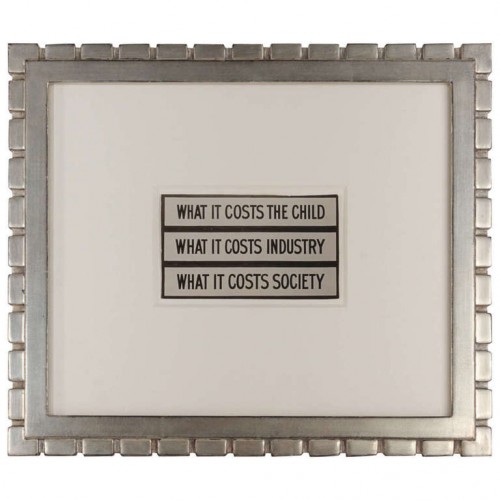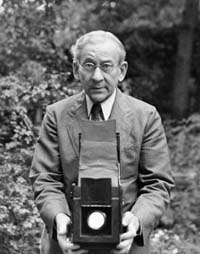Product Description
Lewis Hine, What It Costs The Child/Industry/Society, Silver gelatin print c. 1913-14



LEWIS HINE (1874-1940) USA
What It Costs The Child/Industry/Society c. 1913/14
Silver gelatin print
Signed in script on back
Framed size: H: 14 1/8” x W: 16 3/16”
Price: $20,000
***The same image is in the collection of the Metropolitan Museum of Art, New York.
Lewis Wickes Hine, photographer, sociologist and humanist, is best known for his insightful portraits of immigrants at Ellis Island and his unflinching views of housing and labor conditions in the United States. Studying and eventually teaching at the Ethical Culture School in New York City, Hine infused his humanist concerns into a style of documentary photography that set the standard for delivering a social message through his medium.
The Artist's Joke surveys the rich and diverse uses of satire by avant-garde and contemporary artists. The texts collected in this new reader from London's Whitechapel Gallery examine what Andre Breton called the “lightning bolt” of the unsettlingly comic, as seen in the anarchic wordplay of Duchamp, Picasso, the Dadaists, and Surrealists; Pop's fetish for kitsch and the comic strip; Bruce Nauman's sinister clowns and twisted puns; Richard Prince's joke paintings; art ambushed by feminist wit, from the Dadaism of Hannah Hoch in the 1920s to the politicized conceptualism of Jenny Holzer and Barbara Kruger in the 1980s; the serenely uncanny in Mike Kelley's installations and the risibly grotesque in Paul McCarthy's; and the strangely comic scenarios of artists as various as Maurizio Cattelan, Andrea Fraser, Raymond Pettibon, and David Shrigley. Artists' writings are accompanied and contextualized by the work of critics and thinkers including Freud, Bergson, Helene Cixous, Slavoj Zizek, Lewis Wickes Hine, Jorg Heiser, Jo Anna Isaak, and Ralph Rugoff.
Lewis Hine, What It Costs The Child/Industry/Society, Silver gelatin print c. 1913-14
You must be logged in to post a comment.
ALLEN PORTER (b.1926) USA
Filmstrips 1947
Photogram vintage gelatin silver print
Size: (unframed): H: 11” x W: 14”
Size: (frame): H: 20” x W: 23”
After attending art programs at the Art Institute of Chicago and the Chicago Academy of Fine Arts, Porter enrolled at the ID upon his return from military service in WWII. His course of study included graphic design and photography. His photograms were produced while working with famed ID photography instructors Frank Levstik and Ferenc Berko. Shortly after leaving the ID in 1949, Porter established a design office in Los Angeles during the height of the California modern design movement. He incorporated his innovative light work into design projects for important clients like Gruen Lighting and Carroll Sagar & Associates.
ANDRÈ KÈRTESZ (1894-1985) Hungary
Paris 1927
Silver gelatin print
Signed: Paris 1927, A.Kertesz, Page 150 (in pencil on back); ANDRÈ KÈRTESZ (stamped on back).
Framed size: H: 16 5/8” x W: 17 13/16”
Throughout most of his career, Kertész was depicted as the “unknown soldier” who worked behind the scenes of photography, yet was rarely cited for his work, even into his death in the 1980s. His work itself is often described as predominantly utilizing light and even Kertész himself said that “I write with light”. He was never considered to “comment” on his subjects, but rather capture them – this is often cited as why his work is often overlooked; he stuck to no political agenda and offered no deeper thought to his photographs other than the simplicity of life. With his art’s intimate feeling and nostalgic tone, Kertész’s images alluded to a sense of timelessness that was inevitably only recognized after his death. Unlike other photographers, Kertész’s work gave an insight into his life, showing a chronological order of where he spent his time; for example, many of his French photographs were from cafés where he spent the majority of his time waiting for artistic inspiration. Although Kertész rarely received bad reviews, it was the lack of them that lead to the photographer feeling distant from recognition. Now however, he is often considered to be the father of photojournalism. Even other photographs cite Kertész and his photographs as being inspirational; Henri Cartier-Bresson once said of him in the early 1930s, “We all owe him a great deal”.

Reviews
There are no reviews yet, would you like to submit yours?